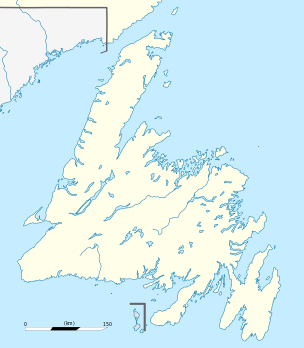Port au Choix
| Port au Choix Portutxoa | ||
|---|---|---|
| Town | ||
|
Port aux Choix lighthouse | ||
| ||
 Port au Choix Location of Port au Choix in Newfoundland | ||
| Coordinates: 50°42′11″N 57°21′08″W / 50.70306°N 57.35222°WCoordinates: 50°42′11″N 57°21′08″W / 50.70306°N 57.35222°W | ||
| Country |
| |
| Province |
| |
| Population (2006) | ||
| • Total | 893 | |
| Time zone | Newfoundland Time (UTC-3:30) | |
| • Summer (DST) | Newfoundland Daylight (UTC-2:30) | |
| Area code(s) | 709 | |
| Website | http://www.pc.gc.ca/lhn-nhs/nl/portauchoix/index.aspx | |
Port au Choix or Port aux Choix is a town in the Canadian province of Newfoundland and Labrador.
History
The earliest European presence in Port au Choix dates to the 16th century when the town received its name, Portuchoa (Portutxoa), meaning "the little port" from Basque fishermen who operated in the area. The town's original European residents were mainly descendants of French and English fishermen who settled in the area after 1904 when France relinquished its rights to fish, and for the first time permanent settlement was allowed. Under the Treaty of Utrecht of 1713, the French were given exclusive rights to fish in an area known as The French Shore, which this area is part of. At Point Riche, The French Shore Treaty monument is erected to commemorate this historic event in Newfoundland history.
Modern town
Known as the "fishing capital" of Western Newfoundland, it boasts a large fishing fleet, a modern shrimp processing plant, Federal Fisheries Offices, Parks Canada Visitor Reception Centre, restaurants, motel, RV Park, modern sports complex, bank, as well as other financial institutions and government services. Port au Choix is an amalgamation of three once separate communities - Old Port au Choix, Gargamelle Cove and Port au Choix. Today's Port au Choix still retains its close association with the sea and its cultural history. There are other sightseeing attractions, including Pointe Riche Lighthouse, the Heritage Museum, the French Shore treaty site, Studio Gargamille, and the fish plant registered to Ocean Choice International.
The nearest airport is Port au Choix Airport, 2.8 km to the southeast.
Population
The population was 505 in 1940 and 214 by 1956. The population increased to 1010 in 2001, then decreased to 893 in 2006.
National Historic Site
Port au Choix is a National Historic Site of Canada, and the community is regarded as one of the richest archeological finds in North America. Burial sites uncovered in the town in the 1960s & 70s provide evidence of its earliest settlers - from the Maritime Archaic Indians to the Groswater and Dorset Palaeoeskimos to the Recent Indians (ancestors of the Beothuks). While prehistoric coastlines elsewhere have long since slipped beneath the encroaching ocean, the raised shoreline and alkaline soil conditions at Port au Choix have combined to preserve a time capsule of great historical importance.
Because of the cultural significance of this burial site, and a successful local lobby, the site was officially designated a National Historic Site in 1970.[1] In 2001, Parks Canada constructed a new Visitor Centre and Museum dedicated to the rich history of these native people - the first ever to inhabit Newfoundland, dating back over 5000 years.
Basque chaloupe
In 2004, through the effort of the 2004 Society, an association of Basque Maritime Heritage, Itsas Begia (The eye of the sea) from Ciboure (Northern Basque Country), came to Newfoundland and shared its ancestral knowledge with Newfoundlanders. Three chaloupes were built, here in Port au Choix, in Conche and in La Scie. The chaloupe is located on Forest Road, in the old Port au Choix cove.
References
- ↑ Port au Choix. Canadian Register of Historic Places. Retrieved 8 July 2012.
External links
| Wikimedia Commons has media related to Port au Choix. |
